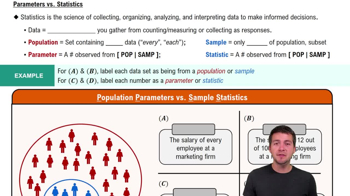Here are the essential concepts you must grasp in order to answer the question correctly.
Population Parameter
A population parameter is a numerical value that summarizes a characteristic of an entire population. In statistics, it is often denoted by symbols such as 'μ' for the mean or 'p' for the proportion. For example, the percentage of all governors in the U.S. who are Republicans represents a population parameter because it refers to the entire group of governors across all states.
Recommended video:
Parameters vs. Statistics
Sample Statistic
A sample statistic is a numerical value that summarizes a characteristic of a sample, which is a subset of the population. It is used to estimate the corresponding population parameter. For instance, if we surveyed a few governors and found that 54% of them were Republicans, this would be a sample statistic, as it is derived from a smaller group rather than the entire population of governors.
Recommended video:
Sampling Distribution of Sample Proportion
Distinction Between Parameter and Statistic
Understanding the distinction between a population parameter and a sample statistic is crucial in statistics. A parameter describes a whole population, while a statistic describes a sample drawn from that population. In the given question, the 54% figure refers to all governors, making it a population parameter, as it does not derive from a sample but rather encompasses the entire group.
Recommended video:
Parameters vs. Statistics
 Verified step by step guidance
Verified step by step guidance Verified video answer for a similar problem:
Verified video answer for a similar problem:



 2:13m
2:13m